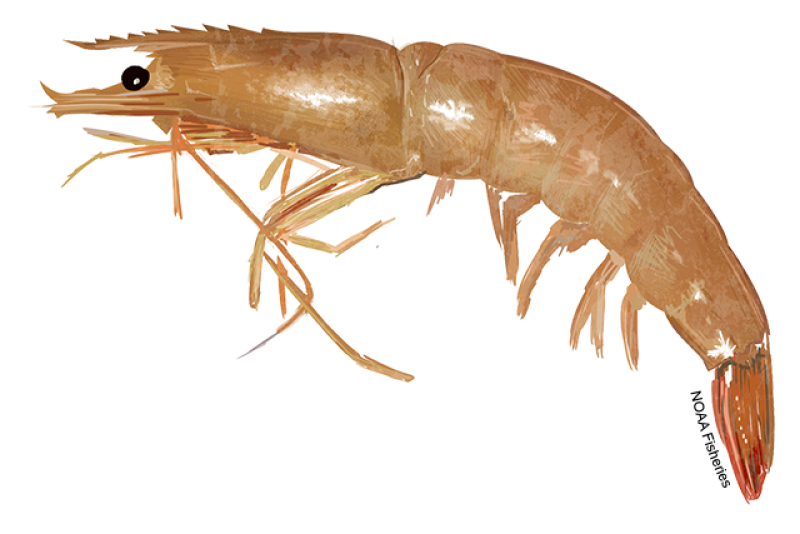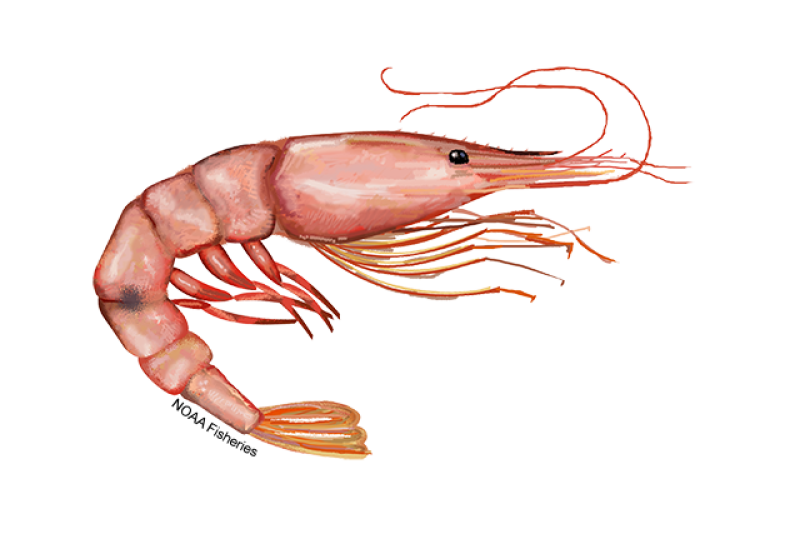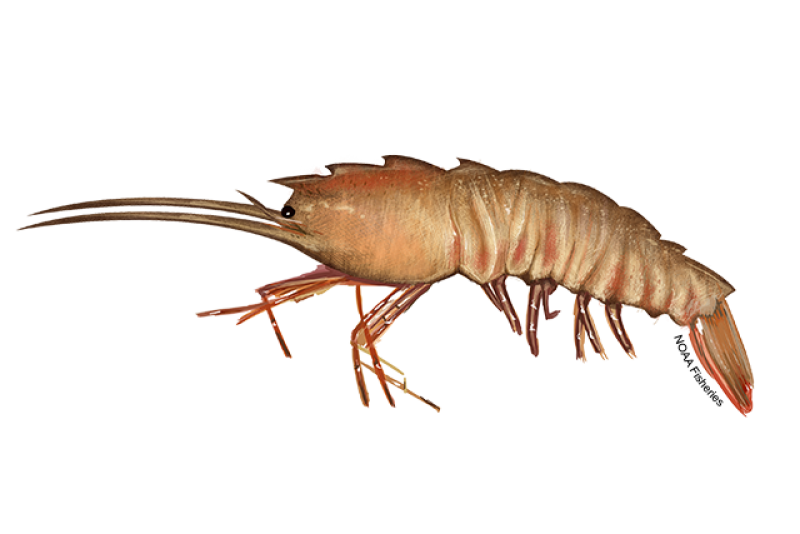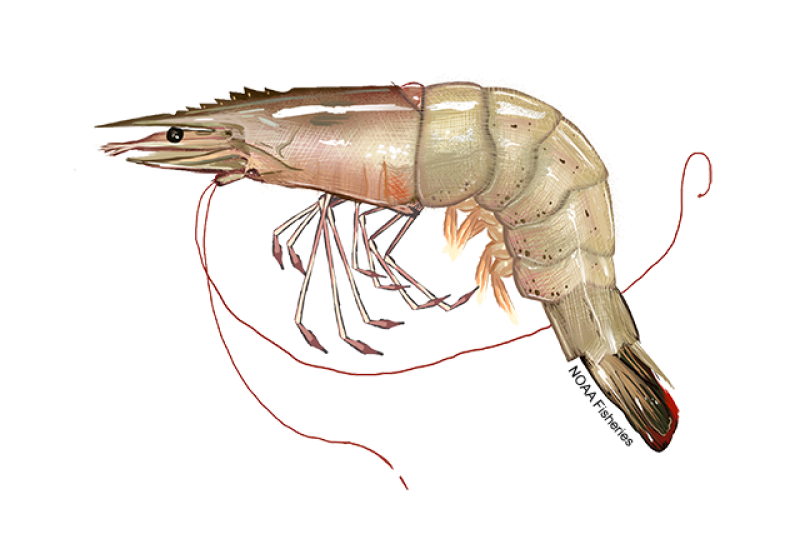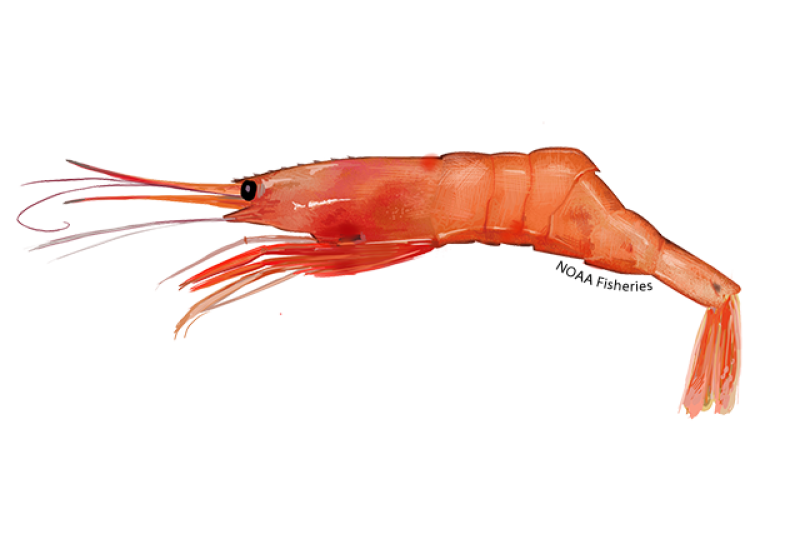 Brown shrimp with a starfish. Credit: NOAA/Ed Bowlby
Brown shrimp with a starfish. Credit: NOAA/Ed Bowlby
Brown shrimp with a starfish. Credit: NOAA/Ed Bowlby
About the Species
 Brown shrimp with a starfish. Credit: NOAA/Ed Bowlby
Brown shrimp with a starfish. Credit: NOAA/Ed Bowlby
Brown shrimp with a starfish. Credit: NOAA/Ed Bowlby
U.S. wild-caught brown shrimp is a smart seafood choice because it is sustainably managed and responsibly harvested under U.S. regulations.

Population
The stocks are not overfished.

Fishing Rate
Not subject to overfishing.

Habitat Impact
Gear restrictions, such as a weak-link in the tickler chain, are in place to protect bottom habitat from trawl gear.

Bycatch
Regulations are in place to minimize bycatch.
Population Status
- There are two stocks of brown shrimp: Gulf of Mexico and South Atlantic. According to the most recent stock assessments:
- The Gulf of Mexico stock is not overfished and not subject to overfishing (2019). Summary stock assessment information can be found on Stock SMART.
- The South Atlantic stock is not overfished and not subject to overfishing (2018). Summary stock assessment information can be found on Stock SMART.
Appearance
- Brown shrimp are crustaceans with 10 slender, relatively long walking legs and five pairs of swimming legs located on the front surface of the abdomen.
- They are grooved on the back surface of the shell and have a well-developed, toothed rostrum (part of their shell) that extends to or beyond the outer edge of the eyes.
- The tails of brown shrimp usually have a purple to reddish purple band and green or red pigmentation.
Biology
- Brown shrimp’s growth depends on factors such as water temperature and salinity, and they can reach up to 7 inches in length.
- They have a short life span, usually less than two years.
- Brown shrimp are able to reproduce when they reach about 5 ½ inches long.
- They spawn in relatively deep water.
- Females typically release about 500,000 to 1 million eggs near the ocean floor.
- Peak spawning is in spring and summer, with newly hatched shrimp entering estuaries in February and March to settle in their nursery habitat.
- Brown shrimp larvae feed on plankton (tiny floating plants and animals).
- Juvenile and adult shrimp feed on the bottom at night. They are omnivorous, and feed on worms, algae, microscopic animals, and various types of organic debris.
- Sheepshead minnows, water boatmen, and insect larvae eat postlarval shrimp.
- Grass shrimp, killifishes, and blue crabs prey on young shrimp.
- A wide variety of finfish feed heavily on juvenile and adult shrimp.
Where They Live
Range
- Brown shrimp are found in the western north Atlantic from Martha’s Vineyard, Massachusetts, to the Florida Keys and along the Gulf Coast to northwestern Yucatan in Mexico.
Habitat
- Brown shrimp live in shallow water, generally less than 180 feet deep, but can be found in water up to 360 feet deep. As they grow, they migrate seaward to deeper, saltier water.
- They travel primarily at night, especially at or shortly after dusk, and bury themselves during the day.
- Inshore, brown shrimp prefer areas with muddy or peaty bottoms rich in organic matter and decaying vegetation.
- Offshore, brown shrimp prefer soft bottoms of mud and sand.
Fishery Management
NOAA Fisheries and the South Atlantic and Gulf of Mexico Fishery Management Councils manage the brown shrimp fishery, and state resource management agencies are responsible for inshore state waters.
- In the South Atlantic, managed under the Shrimp Fishery Management Plan for the South Atlantic Region:
- Permits are required to harvest shrimp in federal waters.
- Trip reports must be submitted for each fishing trip.
- Observers must be carried aboard vessels if selected, to collect data on the catch, bycatch, fishing effort, and fishing gear.
- In the Gulf of America (formerly Gulf of Mexico), managed under the Gulf of Mexico Shrimp Fishery Management Plan:
- Permits are required to harvest shrimp in federal waters. Currently no new permits are being issued to prevent an increase in the number of boats participating in the fishery.
- Electronic logbooks must be installed and selected fishermen must submit trip reports for each fishing trip.
- Observers must be carried aboard vessels if selected, to collect data on the catch, bycatch, fishing effort, and fishing gear.
- Each year all shrimping in federal waters off Texas is closed from approximately mid-May to mid-July.
Harvest
- Commercial fishery:
- In 2023, landings of brown shrimp totaled 63 million pounds and were valued at $80 million, according to the NOAA Fisheries commercial fishing landings database.
- The three species of penaeid shrimp (white, pink, and brown) make up the vast majority of the shrimp harvested in the southeast. This fishery is one of the most valuable fisheries in the southeastern United States.
- Almost all of the brown shrimp harvested in the United States comes from the Gulf of America, mainly from Texas and Louisiana.
- Annual harvests of brown shrimp vary considerably from year to year, primarily due to environmental conditions affecting population size.
- Gear types, habitat impacts, and bycatch:
- Commercial fishermen harvest shrimp with trawls towed near the ocean floor. The nets are wide in the front and taper toward the back.
- Shrimpers using otter trawl gear in the South Atlantic and Gulf of America are required to use sea turtle excluder devices (TEDs).
- Some shrimp trawlers must also install bycatch reduction devices behind the TED, to reduce finfish bycatch.
- Area closures if fishing effort exceeds certain thresholds.
- Trawlers in the Gulf of America must have a weak-link in the tickler chain, which hangs in front of the net and drags along the ocean floor to stir up shrimp from the bottom into the net. This weak-link allows the tickler chain to drop away if it gets hung up on natural bottom structures.
- Fishermen do not trawl in areas with coral reefs and other known areas of high-relief to avoid damage to their nets.
- Recreational fishery:
- Under federal management, there is no recognized recreational fishery. Fishing in federal waters requires a permit.
- Recreational fishermen catch brown shrimp seasonally and almost always in state waters. State regulations vary from state to state.
Scientific Classification
- Brown shrimp are found in the western north Atlantic from Martha’s Vineyard, Massachusetts, to the Florida Keys and along the Gulf Coast to northwestern Yucatan in Mexico.
- Brown shrimp live in shallow water, generally less than 180 feet deep, but can be found in water up to 360 feet deep. As they grow, they migrate seaward to deeper, saltier water.
- They travel primarily at night, especially at or shortly after dusk, and bury themselves during the day.
- Inshore, brown shrimp prefer areas with muddy or peaty bottoms rich in organic matter and decaying vegetation.
- Offshore, brown shrimp prefer soft bottoms of mud and sand.
Fishery Management
NOAA Fisheries and the South Atlantic and Gulf of Mexico Fishery Management Councils manage the brown shrimp fishery, and state resource management agencies are responsible for inshore state waters.
- In the South Atlantic, managed under the Shrimp Fishery Management Plan for the South Atlantic Region:
- Permits are required to harvest shrimp in federal waters.
- Trip reports must be submitted for each fishing trip.
- Observers must be carried aboard vessels if selected, to collect data on the catch, bycatch, fishing effort, and fishing gear.
- In the Gulf of America (formerly Gulf of Mexico), managed under the Gulf of Mexico Shrimp Fishery Management Plan:
- Permits are required to harvest shrimp in federal waters. Currently no new permits are being issued to prevent an increase in the number of boats participating in the fishery.
- Electronic logbooks must be installed and selected fishermen must submit trip reports for each fishing trip.
- Observers must be carried aboard vessels if selected, to collect data on the catch, bycatch, fishing effort, and fishing gear.
- Each year all shrimping in federal waters off Texas is closed from approximately mid-May to mid-July.
Harvest
- Commercial fishery:
- In 2023, landings of brown shrimp totaled 63 million pounds and were valued at $80 million, according to the NOAA Fisheries commercial fishing landings database.
- The three species of penaeid shrimp (white, pink, and brown) make up the vast majority of the shrimp harvested in the southeast. This fishery is one of the most valuable fisheries in the southeastern United States.
- Almost all of the brown shrimp harvested in the United States comes from the Gulf of America, mainly from Texas and Louisiana.
- Annual harvests of brown shrimp vary considerably from year to year, primarily due to environmental conditions affecting population size.
- Gear types, habitat impacts, and bycatch:
- Commercial fishermen harvest shrimp with trawls towed near the ocean floor. The nets are wide in the front and taper toward the back.
- Shrimpers using otter trawl gear in the South Atlantic and Gulf of America are required to use sea turtle excluder devices (TEDs).
- Some shrimp trawlers must also install bycatch reduction devices behind the TED, to reduce finfish bycatch.
- Area closures if fishing effort exceeds certain thresholds.
- Trawlers in the Gulf of America must have a weak-link in the tickler chain, which hangs in front of the net and drags along the ocean floor to stir up shrimp from the bottom into the net. This weak-link allows the tickler chain to drop away if it gets hung up on natural bottom structures.
- Fishermen do not trawl in areas with coral reefs and other known areas of high-relief to avoid damage to their nets.
- Recreational fishery:
- Under federal management, there is no recognized recreational fishery. Fishing in federal waters requires a permit.
- Recreational fishermen catch brown shrimp seasonally and almost always in state waters. State regulations vary from state to state.
Scientific Classification
| Kingdom | Animalia | Phylum | Arthropoda | Class | Malacostraca | Order | Decapoda | Family | Penaeidae | Genus | Farfantepenaeus | Species | aztecus |
|---|
Last updated by NOAA Fisheries on 05/22/2025
Featured News
 Celebrate Culinary Arts Month with a sustainable seafood recipe for every month of the year.
Celebrate Culinary Arts Month with a sustainable seafood recipe for every month of the year.
What Your Birth Month Says About Your Next Seafood Recipe
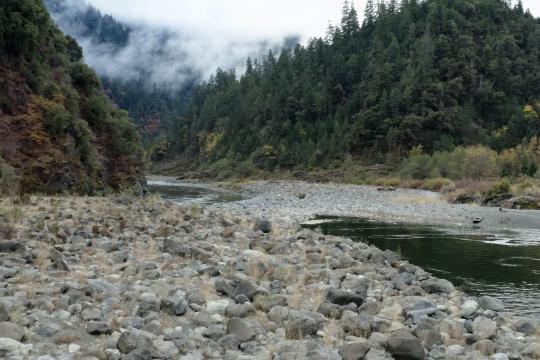 Klamath River. Credit: Shane Anderson.
Klamath River. Credit: Shane Anderson.
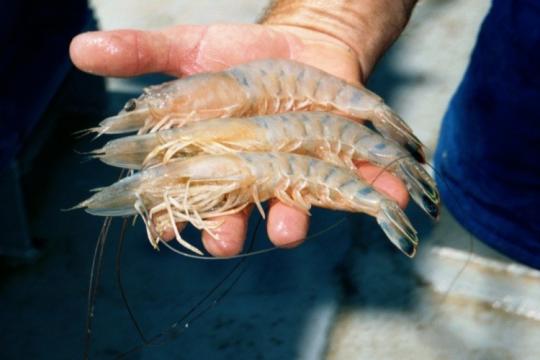 Penaeid shrimp (white shrimp pictured here) are one of the most valued species in the Gulf of America. Credit: NOAA Fisheries
Penaeid shrimp (white shrimp pictured here) are one of the most valued species in the Gulf of America. Credit: NOAA Fisheries
Seafood Facts

Are Brown Shrimp Sustainable?
U.S. wild-caught brown shrimp is a smart seafood choice because it is sustainably managed and responsibly harvested under U.S. regulations.
Availability
Year-round, with peaks in the summer.
Source
U.S. wild-caught from North Carolina to Texas.
Taste
Flavorful and sweet. Brown shrimp sometimes have a slight iodine taste.
Texture
Firm.
Color
Raw shrimp meat is translucent pink to gray. When cooked, their shells are pinkish-red and their meat is pearly white with pink and red shadings.
Health Benefits
Shrimp is low in saturated fat and is a very good source of protein, selenium, and vitamin B12.
Nutrition Facts
Servings: 1; Serving Weight: 100 g (raw); Calories: 106 ; Protein: 20.31 g; Total Fat: 1.73 g; Total Saturated Fatty Acids: 0.328 g; Carbohydrate: 0.91 g; Total Sugars: 0 g; Total Dietary Fiber: 0 g; Cholesterol: 152 mg; Selenium: 38 mcg; Sodium: 148 mgMore Information
Shrimp Recipes
Looking for some ways to add shrimp into your rotation? If you need cooking inspiration, browse these recipes for shrimp grilled with herb butter, easy sheet pan shrimp fajitas, and more!
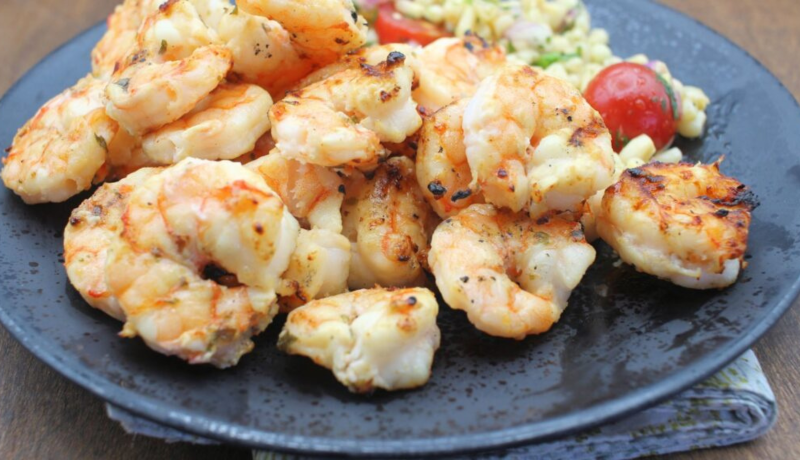
Last updated by NOAA Fisheries on 05/22/2025
Seafood News
 Celebrate Culinary Arts Month with a sustainable seafood recipe for every month of the year.
Celebrate Culinary Arts Month with a sustainable seafood recipe for every month of the year.
What Your Birth Month Says About Your Next Seafood Recipe
 Fresh-caught taʻape on ice. Credit: Conservation International Hawaiʻi.
Fresh-caught taʻape on ice. Credit: Conservation International Hawaiʻi.
Reducing Waste and Feeding Communities in Hawaiʻi with a Whole Fish Approach
 Chef Tyler Hadfield’s Curried Skate Wings with Tomato-Masala Chutney
Chef Tyler Hadfield’s Curried Skate Wings with Tomato-Masala Chutney
Ring In the New Year With These Crowd-Favorite Seafood Recipes
 NOAA Fisheries, in collaboration with Blue Ocean Mariculture, is conducting a multi-year pilot study to evaluate observational methods and tools for studying Hawaiian monk seal behavior. Courtesy of Blue Ocean Mariculture
NOAA Fisheries, in collaboration with Blue Ocean Mariculture, is conducting a multi-year pilot study to evaluate observational methods and tools for studying Hawaiian monk seal behavior. Courtesy of Blue Ocean Mariculture
AI Meets Aquaculture to Study Hawaiian Monk Seal Interactions With Net Pens
Documents
The annual economic survey of federal Gulf shrimp permit holders : report on the design, implementation, and descriptive results for 2006
Christopher Liese, Michael D. Travis, Diana Pina, and James R. Waters
The annual economic survey of federal Gulf shrimp permit holders : implementation and descriptive results for 2007
Christopher Liese, Michael D. Travis, and James R. Waters
The annual economic survey of federal Gulf shrimp permit holders : implementation and descriptive results for 2008
Christopher Liese and Michael D. Travis
Data & Maps
Research
Shrimp Futures Initiative
NOAA’s Southeast Fisheries Science Center is working to understand the profound challenges facing the Southeast’s shrimp fisheries to help prepare for their uncertain future.
Experimental Shrimp Trawl Bycatch Reduction Device
For more information, please contact sustainable fisheries at (727) 824-5305
Last updated by NOAA Fisheries on 05/22/2025
